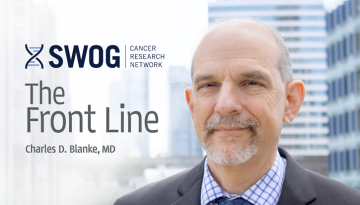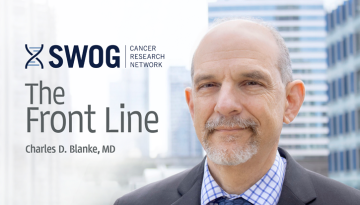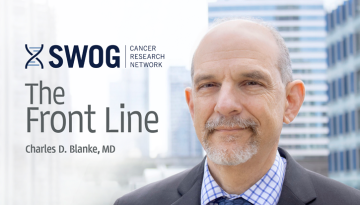How an Idea Becomes a Trial
Those of a certain age may remember the Schoolhouse Rock episode "how a bill becomes a law." Somehow, it's a touchstone for my generation. I'd like to give you the SWOG version – how an idea becomes a clinical trial. Luckily, I won't sing the song "I'm just a bill, and I'm sittin' on Capitol Hill …." But I do remember all the words.
It’s a pretty complex process, and can be a little dry, so my challenge is whether or not I can tell the story in about 500 words and make it sufficiently interesting and clear so that our members reading this walk away with a big-picture view of the process.
Here goes.
SWOG does team science. If you’re an investigator with a great idea, spread it around, and do so early. Discuss it in the appropriate research (or research support) committee. Do your colleagues, including your advocate, find it innovative and/or important and feasible? Is it a trial they’d consider opening and enrolling to? Your committee chairs or co-chairs need to be completely on board.
For trials going through NCORP committees, you’ll need an initial review of your idea on the NCORP executive committee monthly call to assess feasibility and priority. Whether NCORP or CTEP, at this point the committee statistician, patient advocate, and protocol project manager are your budding trial’s best friends. Keep them in the loop. With their input and agreement, draft a capsule using the appropriate capsule summary form. When all are satisfied with it, send it off to central statistical review. Incorporate stats’ feedback, and you’re (hopefully) ready for triage (assuming you’ve completed the Study Chair Workshop). Prepare the triage slide set, ask your patient advocate to prepare their review slide, and submit to triage.
On your assigned Monday, present your proposal, alongside your patient advocate, to SWOG’s executive committee. Your committee chair and statistician may also weigh in. Expect questions. Then hang up so the committee can discuss your capsule and vote. Expect a letter within a week with their decision: up, down, or “fix these things and resubmit.”
If your capsule is voted up, congratulations – you now have a study number!
If your committee determines your proposal is its top development priority, the next step is the financial & feasibility call. Just how practicable would it be for the network to conduct your trial? SWOG’s budgeting and contracting professionals get involved. This call will identify issues that need to be resolved before we can submit a letter of intent (LOI, for phase 1 and 2 trials) or a concept (large phase 2 and phase 3 studies) to CTEP or DCP for review.
Your concept or LOI may be reviewed by an NCI scientific steering committee, and the OEWG clock will start ticking. What’s the OEWG clock? If your trial has not been activated within a given number of days (varies from 400 to 540, depending on the phase), the NCI will cut it loose.
If CTEP or DCP approves your concept or LOI (it may take several rounds of review, response, and resubmission), congratulations once again! We now have 60 – 90 days to draft the full protocol. Luckily, SWOG has templates to build on and highly experienced staff to provide direction and help at all stages. Our protocol department has been through this before – about 1,300 times.
Protocols will typically go through four formal draft stages – the initial draft, the RaPID draft (reviewed in a four-hour Re-engineering Protocol Implementation and Development call), and the Protocol Review Committee (PRC) draft (reviewed by the PRC at the Statistics and Data Management Center). Once all feedback from the PRC review has been incorporated, the protocol is ready for submission to CTEP or DCP. For many trials, the protocol is also sent for FDA review.
CTEP or DCP typically send reviewed protocols back with queries and requests for revisions. This consensus review cycle will, in most cases, eventually lead to “approval on hold,” indicating the protocol and associated materials are ready for review by the NCI’s Central Institutional Review Board (CIRB). Eventual final approval by CIRB will be followed by full approval from CTEP or DCP.
Activation date approaches, but only if all other pieces are complete: funding is in place, contracts with pharma partners are fully executed, drugs are in stock at the distributors, TM components are fully approved, SWOG’s Statistical and Data Management Center has completed testing on its study build, and more. When all elements are aligned, an activation date is set, the protocol and other materials are posted to ctsu.org, an activation memo is sent out, and activation is announced in the twice-a-month protocol broadcasts by SWOG and CTSU.
Congratulations – your idea has become a trial!
And for those of you counting, I said about 500 words.
___________________________________________________
Trial of the Week
S1912CD: A Randomized Trial Addressing Cancer-Related Financial Hardship Through Delivery of a Proactive Financial Navigation Intervention (CREDIT)
A follow-up to the landmark S1417CD trial, which was the first study of financial toxicity in the National Clinical Trials Network, the S1912CD CREDIT study is testing the efficacy of a financial counseling intervention for relieving financial hardship and improving quality of life for patients being treated for cancer.
Patients enrolled to the trial and their spouses get financial counseling to help them navigate the financial challenges of a cancer diagnosis and subsequent treatment.
The study activated in July of 2021, and to date has accrued 111 of a planned 326 patients, at 52 sites, out of 267 sites that have opened the trial.
Note that participation in S1912CD is limited to NCORP institutions only.
Columbia University Medical Center/Herbert Irving Comprehensive Cancer Center (the Columbia University Minority-Underserved NCORP) and PeaceHealth Saint Joseph Medical Center in Washington state (part of the Pacific Cancer Research Consortium NCORP) are the leading accruers to the study.
The study chair is Veena Shankaran, MD, MS, of Fred Hutchinson Cancer Center.
You can learn more on the SWOG S1912CD page or the CTSU S1912CD page.
Other Recent Stories



